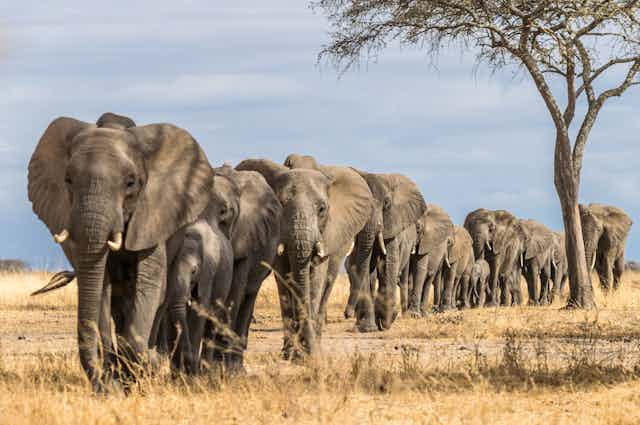Imagine you’re in a hot air balloon flying over an African savanna in the late growing season. Below, herds of elephants, zebras, wildebeests and rhinos roam a mosaic landscape dotted with lonesome trees and daubs of woodland on a canvas of yellow-brown grass. The hungry and rowdy herbivores are eating and trampling the vegetation that stores carbon and keeps it from heating the atmosphere.
You’d be forgiven for thinking that their voracious appetites and blundering steps might be disturbing and releasing the carbon stored in this ecosystem in much the same way wildfires do. But, incredibly, the way herbivores disturb the landscape actually helps it lock up more carbon in durable stores that are difficult to reach. In a new review which compiled evidence from lots of different studies, we uncovered how large herbivores could help slow climate change this way.
Forests are often evoked as the ultimate vessels for storing carbon. But carbon in the bark and leaves of trees is vulnerable to logging, pests and fires which can unleash decades of accumulated carbon in a matter of hours. Even in healthy forests, most of the carbon stored in vegetation above ground is decomposed and recycled to the atmosphere as greenhouse gas in less than a century.

Meanwhile, the soil beneath savannas and grasslands where trees are sparse but herbivores are abundant can guard carbon for thousands and even tens of thousands of years in hard-to-reach underground pools. So how is this possible?
Research from 2009 showed how wildebeests returning to the Serengeti savanna of east Africa after a virus tore through their populations led to fewer catastrophic wildfires. Because the wildebeests trampled and ate the vegetation that had been fuelling the fires in their absence, their return in the 1960s allowed the plants to gradually reestablish and recover their pre-epidemic abundance, along with the carbon the landscape’s soil was storing.
Read more: How bison, moose and caribou stepped in to do the cleaning work of extinct mammoths
This may sound counter-intuitive, but large herbivores and seasonal fires are natural elements of grassland ecosystems. Without wildebeests keeping on top of all that fuel, small fires turn into catastrophic blazes and consume everything.
But does it really matter for the climate whether herbivores or fires consume the vegetation? If you assume that 100% of the carbon in vegetation is released to the atmosphere as greenhouse gasses from fires or elephant digestion, then it shouldn’t.
But this isn’t what really happens. For one thing, the burned carbon that remains in the soil after a fire is resistant to decomposition by microbes, and often called black carbon.

Meanwhile, up to half of the plant material eaten by large herbivores is excreted as dung and urine, which tends to be easier for decomposers in the soil (such as beetles, earthworms, fungi and bacteria) to break down compared to plant litter like dead leaves and fallen logs. Scientists once assumed that plant material eaten by microbes or animals was lost from the soil. But recent discoveries suggest this picture is far too simple.
While some of what’s eaten by decomposers is released as CO₂ to the atmosphere, most of it enters persistent soil pools of carbon. An effective way of forming long-term stores of carbon underground then is to feed the soil with easily decomposable organic material.
Large animals seem adept at reorganising where ecosystems store carbon, directing a larger fraction towards persistent and stable reservoirs underground. This shows how valuable intact wildlife communities can be, and should urge us to protect the few remaining herbivore-rich ecosystems on Earth, such as the African savanna. We may restore so much more by restoring nature’s four-legged ecosystem engineers in the places they have been lost.


